|
Secret Features
The Secret Arcade is designed to be the ultimate gaming cabinet. To meet this goal, many features must work together.
Lower Cabinet
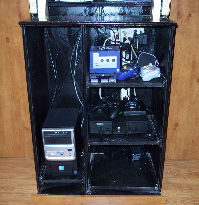 The Lower Cabinet is where all of the game components go--the PC and the consoles. It also has most of the wiring routed through it, and has two power strips attached to the back wall. All components are on pull-out shelves for easy configuration. The Lower Cabinet is where all of the game components go--the PC and the consoles. It also has most of the wiring routed through it, and has two power strips attached to the back wall. All components are on pull-out shelves for easy configuration. |
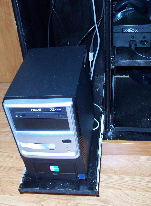 The size of the O'Sullivan wardrobe limited the size of the cabinet, so the Secret Arcade required a PC with a relatively small case. The PC also needs USB for the various control panels. This was made by ASUS, it has a 1.7 Ghz Celeron processor in it. The size of the O'Sullivan wardrobe limited the size of the cabinet, so the Secret Arcade required a PC with a relatively small case. The PC also needs USB for the various control panels. This was made by ASUS, it has a 1.7 Ghz Celeron processor in it. |
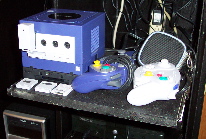 Nintendo's GameCube fits on one of our shelves with lots of room for memory cards and controllers. I like the wavebird controller personally. Nintendo's GameCube fits on one of our shelves with lots of room for memory cards and controllers. I like the wavebird controller personally. |
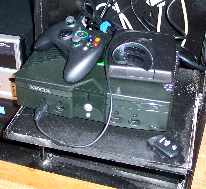 Microsoft's XBox is larger, but still fits on the shelf with room for accessories. It could be connected to our wireless internet connection (described below), but I don't use XBox Live Microsoft's XBox is larger, but still fits on the shelf with room for accessories. It could be connected to our wireless internet connection (described below), but I don't use XBox Live |
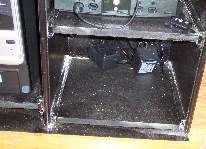 No PlayStation/2 or other console at the moment. I'll be watching for sales when Christmas draws near. No PlayStation/2 or other console at the moment. I'll be watching for sales when Christmas draws near. |
Control Panels on arms
Audio and Video
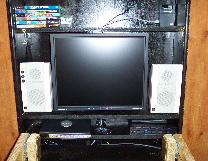 The secret arcade must be able to route both PC video and console video onto a thin display. The secret arcade must be able to route both PC video and console video onto a thin display.
I chose a 20" Samsung Syncmaster LCD to use for my video, I've had good luck with Samsung LCDs.
The monitor is attached to a ViewSonic video processor. It can switch inputs between a VGA input (PC), RCA input (consoles), or even a coax console to its built-in TV tuner. This could be used to watch TV. However, explaining what a coax cable is doing attached to your O'Sullivan cabinet can spoil the secret. The ViewSonic will also route audio connections.
The consoles are all attached to a Pelican RF/AV System Switcher, which passes the selected device's signal to the ViewSonic. I chose it because it was good looking, took 5 inputs, and had interhcangeable labels for the front panel.
The ViewSonic represents perhaps the biggest design goof I made. The shelf is six inches deep, designed to hold the ViewSonic and the Pelican. Unfortunately, I measured the boxes without having cables attached. While the Pelican still fits nicely, the ViewSonic sticks out badly.
|
Wireless Internet
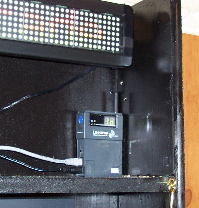 Any computer should be connected to the internet. Also, the game consoles now all have online gaming. But, how do we avoid a suspicious cable going into the cabinet? Any computer should be connected to the internet. Also, the game consoles now all have online gaming. But, how do we avoid a suspicious cable going into the cabinet?
Linksys has a small device that provides wireless access for a single component, just connect an ethernet cord from the Linksys to the component. In the current secret arcade, I have it connected to the PC. I should be able to connect it to an Ethernet hub to connect to the game consoles as well.
|
Attract Bar
 This obviously is not a necessary part of the secret arcade. But, most arcades have flashing signs over the entrance, and so should the secret arcade. The sign can be programmed with fairly complex routines, I just have it displaying "Welcome to the Secret Arcade" This obviously is not a necessary part of the secret arcade. But, most arcades have flashing signs over the entrance, and so should the secret arcade. The sign can be programmed with fairly complex routines, I just have it displaying "Welcome to the Secret Arcade" |
|
|